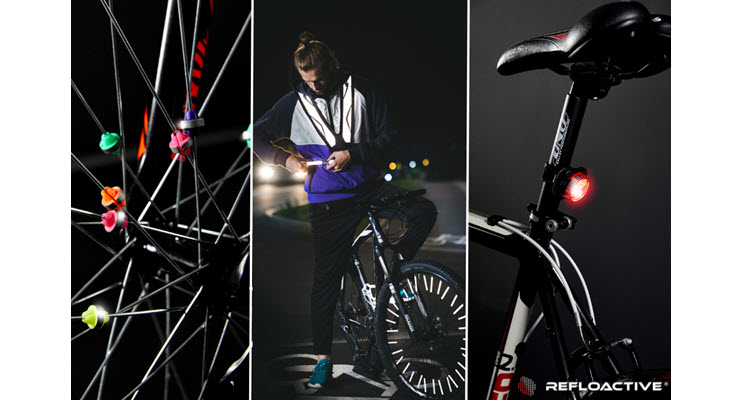Bicycle&Reflectors – perfect match!
Where and how to mount reflectors on a bicycle?
Road safety is crucial for every cyclist, and reflectors are one of the most important elements for increasing visibility. Properly mounted reflectors can be lifesaving, making a cyclist visible to drivers in all conditions. In this article, we’ll explain the best places to install reflectors on your bike and how to do it correctly.
How to attach reflectors to spokes
Spoke reflectors are one of the most effective placement options, providing side visibility for the bike, which is essential at intersections and in traffic.
Choose Reflectors
Start by choosing the right spoke reflectors. Options include tubular reflectors that easily snap onto the spokes or reflective stickers designed for spokes.
- Mounting Tubular Reflectors
To attach tubular reflectors directly to spokes, follow these steps:
- Open the tubular reflector,
- Position it around the spoke,
- Snap the reflector onto the spoke until you hear a click, indicating it’s securely in place,
- Repeat this process on several spokes at even intervals for balanced visibility.
- Mounting Reflective Stickers
If you’re using reflective stickers:
- Ensure the spokes are clean and dry,
- Peel off the sticker backing and attach it evenly to the spoke,
- Smooth the sticker to ensure it adheres well to the surface.
Where to mount reflectors on a bike
Reflectors can be mounted in several key areas on the bike to ensure maximum visibility from different angles.
- Front Reflectors
The front reflector should be mounted on the bike’s fork or handlebars. It is typically white, ensuring visibility for oncoming traffic.
- Rear Reflectors
Rear reflectors are attached to the rear fork or under the seat and should be red to make the bike visible to vehicles approaching from behind.
- Pedal Reflectors
Pedal reflectors are another essential component. They provide side visibility while pedaling, which catches drivers’ attention. Most pedals come with built-in reflectors, but additional covers can be purchased if needed.
- Frame Reflectors
Frame reflectors can be placed on the down tube, seat tube, or chainstays. Reflective stickers work well for this purpose, as they can be easily adapted to the bike’s shape.
- Wheels and Spokes
As mentioned, spoke and wheel reflectors are essential for side visibility. They should be evenly spaced around the wheel for optimal visibility.
How to properly install reflectors on a bike
Proper reflector installation is key to effectiveness. Follow these steps:
Preparing the Bike
Ensure the bike is clean and dry. Dirt and moisture can reduce the adhesion of reflective stickers.
Choosing Placement
Select locations on the bike where you’ll mount the reflectors. Ensure they are highly visible and won’t interfere with riding.
Mounting Reflectors
Follow the manufacturer’s instructions for mounting reflectors. For stickers, peel off the backing and press the reflector firmly onto the bike frame. For tubular reflectors, snap them onto the spokes as described.
Visibility Test
After mounting, check the bike’s visibility in various lighting conditions to ensure the reflectors are visible from the front, rear, and sides.
How to choose the right size reflective cap
Although our focus is on bike reflectors, it’s also worth mentioning the importance of selecting the right reflective cap for added cyclist visibility.
- Measuring head circumference
To choose the right cap size, measure your head circumference at forehead level using a measuring tape, keeping it flat.
- Checking the size chart
Consult the manufacturer’s size chart to select the correct size, as sizing can vary by brand.
- Fitting the cap
The cap should fit snugly without being too tight, ensuring comfort and stability while riding.
What materials are best for a durable and comfortable reflective cap?
Choosing the right material for a reflective cap is essential for comfort and durability.
- Breathable Materials
Caps made from breathable materials, such as polyester or polyester-cotton blends, ensure comfort and ventilation.
- Water Resistance
Water-resistant materials are ideal for rainy days, keeping the cap dry and the reflectors visible in challenging weather.
- Elasticity
Stretchy materials, such as spandex, allow for a better fit, enhancing comfort.
- Durability
The material should be durable and resistant to wear, ensuring long-term use of the cap.
Technical features that maximize visibility
High-quality reflectors that reflect light from a distance are essential. Look for caps with certified reflectors.
Bright colors, such as neon yellow or orange, increase daytime visibility.
Caps with large, well-positioned reflective areas ensure visibility from multiple angles.
Some caps feature built-in LED lights that further enhance visibility in the dark.
Where to find high-quality reflective caps
- Sporting Goods Stores
Sporting goods stores offer a wide selection of reflective caps designed for cyclists and runners. Look for products from reputable brands.
- Online Stores
Shopping online allows you to compare a variety of products and customer reviews. Choose trusted stores with good return policies.
- Workwear Stores
Workwear stores often carry reflective clothing. Safety stores may offer durable and comfortable reflective caps suited for outdoor use.
Bike reflectors: http://refloactive.com/shop/bike
Reflective vests: http://refloactive.com/shop/vests-2
Reflective stickers: http://refloactive.com/shop/stickers-3
LED reflectors: http://refloactive.com/shop/led-2
Reflective accessories: http://refloactive.com/shop/led-2
Refloactive Sp. z o.o.
Aneta Niciak
Our Website: https://refloactive.com/
e-mail: office@refloactive.com
tel. +48 603 620 774
address: Fordońska 40, 85-719 Bydgoszcz, Poland
Published on: November 21st, 2024





